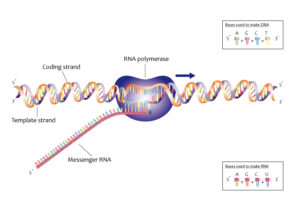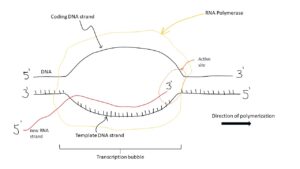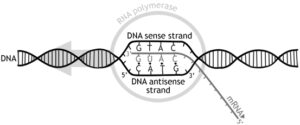Transcription in DNA is the process in which a portion of the DNA is transcribed or copied into a RNA molecule.
The DNA transcription types- There are two types of DNA transcription, they are the prokaryotic transcription of DNA and the Eukaryotic transcription of DNA. Both are majorly the same but the prokaryotic transcription of DNA is quite simple than the eukaryotic which is complex by nature.
This article completely focuses on eukaryotic and prokaryotic transcription.
Read more on Biosynthesis of Purines and Pyrimidines | An important part of cellular metabolism
What are the DNA transcription types in prokaryotes?
The DNA transcription process in prokaryotes is simple and is of only one type that consists of 3 steps.
Transcription in DNA is the process in which a portion of the DNA is transcribed or copied into a Messenger RNA or mRNA strand with the help of an enzyme called RNA polymerase.
This process is initiated at a specific DNA sequence which is commonly called the promoter region.
The enzyme RNA polymerase adds Ribo- nucleotides to the template DNA strand.

Image credits- Wikimedia
Initiation:
Initiation consists have 3 types
Closed complex
- Closed complex is when the RNA polymerase attaches to the promoter region of DNA sequence.
- Like in DNA replication- DNA polymerase, RNA polymerase does not require any enzyme like primase to initiate its desired process.
Open complex
- Open complex happens when the enzyme that is bound to the DNA sequence unwinds the double stranded DNA at a certain or specific portion, this is called the open complex.
- Now the addition of rNTPs or the ribo-nucleotides to the template DNA will be done.
- The end product will be short stretches of RNA strand produced complementary to the template DNA.
Abortive initiation
Abortive initiation is a process in which the sigma factors block the RNA exit channel of RNA polymerase enzymes.
Elongation:
- The sigma factor in the RNA polymerase will be released and the elongation of the RNA strand complementary to the template DNA strand is done.
- The elongation is a process in which the RNA strand will keep on synthesizing, that is the strand will be elongating with the addition of rNTPs.
Termination:
There has to be a stop point to end this transcribing process and this is called the termination process.
In prokaryotes, the termination process will be of 2 types.
Rho independent:
- This is also called the intrinsic terminators.
- This type of termination does not require any external proteins.
- This consist of 2 sequence elements, they are
Short inverted repeats
Examples of inverted repeats are
Example – I
– – – – – – – – G T A G C A T T C G G – – – – – – – – – C C G A A T G C T A C – – – – – – –
– – – – – – – – C A T C G T A A G C C – – – – – – – – – G G C T T A C G A T G – – – – – – –
Example – II
– – – – – – – – T A G C A T T C G G T- – – – – – – – A C C G A A T G C T A- – – – – – –
– – – – – – – – A T C G T A A G C C A- – – – – – – – T G G C T T A C G A T- – – – – – –
Example – III
– – – – – – – – G T A G C A T T C G G T- – – – – – – – A C C G A A T G C T A C- – – – – – –
– – – – – – – – C A T C G T A A G C C A- – – – – – – -T G G C T T A C G A T G- – – – – – –
A T rich sequence
– – G T A G C A T T C G G – – – – – – – – C C G A A T G C T A C – – – – A A A A
– – C A T C G T A A G C C – – – – – – – – G G C T T A C G A T G – – – – T T T T
- The inverted repeated sequences are always followed by AT rich sequences.
- Now due to this inverted sequence and AT rich sequence at the end, a hairpin like structure will be formed by pairing of the bases in the same strand which then halts the complete process.
- Finally the A T rich sequence becomes A U rich sequence as in RNA thymine is replaced by uracil.
- Of all the base pairs ( A – T ; T – A ; C – G ; G – C ; A – U; U – A), A-U or U – A is the weakest pair.
- Due to this weak element, this is the end and the RNA will be released and the process is terminated.
Rho dependent:
- This type of termination process requires a Rho protein to terminate the process of transcription.
- This Rho protein is a hexameric protein and requires ATP molecules for its action.
- This Rho protein binds to the RNA sequence rich in C or Cytosine, which are also known as Rho utilization sites or the RUT site.
- Example: – – – – – – – – C C C C C C – – – – – – –
- This will eventually become the Rho sensitive pause site and unwinds the region.
- Now the end product will be a strand of RNA that is released from the template DNA, this is the process of prokaryotic DNA transcription.
Read more on Adenosine nucleoside and nucleoside phosphoramidite | Overview of important aspects
What are the types of transcription process in eukaryotes?
In eukaryotes, the DNA transcription is quite more complex than the prokaryotes, but yes the basic concept and steps are quite similar.
In eukaryotes, the transcription of DNA is done by 3 type of enzymes called RNA Polymerase I,RNA Polymerase II and RNA Polymerase III.
The RNA polymerase- I is present in nucleolus and works on the 28S, 18S, and 5.8S rRNA genes.
The RNA polymerase- II is present on the nucleoplasm and works on the protein coding genes.
The RNA polymerase III is also seen in nucleoplasm and works on tRNA, 5S rRNA, U6 snRNA, and the 7S RNA and few more other factors.

Image credits- Flickr
Transcription in eukaryotes happens inside the nucleus organelle and mRNA leaves the nucleus and enters the cytoplasm for the translation process.
The initiation of RNA synthesis by RNA polymerase using the complementary DNA strand is done by the appearance and recognition of a promoter site on the 5’ side of the transcriptional start site.
The elongation process proceeds and the mRNA strand will be synthesized using the targeted enzyme.
The termination process will be initiated at one point in the cleaved site and thus the process is stopped.
Though the mRNA strand is produced, it has both the coding sequence and non coding sequence on it. So it has to undergo another process called the post transcriptional modification in which the non coding sequence will be removed.

Image credits- Wikimedia
This is the summary of the eukaryotic transcription of DNA including the process and the types,enzymes used.
Read more on Nucleotide Excision Repair and Single Nucleotide Polymorphism | An Important discussion
What are DNA transcription types in Bacteria?
The DNA transcription process in bacteria is so simple and it consists of only one type with 3 steps.
Initiation:
- In bacteria, this process is initiated at a specific DNA sequence which is commonly called the promoter region.
- The enzyme RNA polymerase adds Ribo- nucleotides to the template DNA strand.
Initiation consists have 3 types
Closed complex and open complex has already discussed in the same article, please click here to read more on the closed complex and open complex.
Abortive initiation
Abortive initiation in bacteria is a process in which the sigma factors block the RNA exit channel of RNA polymerase enzymes.

Image credits- Wikimedia
Elongation:
- The sigma factor in the RNA polymerase will be released and the elongation of the RNA strand complementary to the template DNA strand is done.
- The elongation is a process in which the RNA strand will keep on synthesizing, that is the strand will be elongating with the addition of rNTPs.
Termination:
- There has to be a stop point to end this transcribing process and this is called the termination process.
- In bacteria, the termination process will be of 2 types.
Rho independent:
- This is also called the intrinsic terminators.
- This type of termination does not require any external proteins.
- This consist of 2 sequence elements, they are
Short inverted repeats
Example of inverted repeats are
– – – – – – – – G T A G C A T T C G G – – – – – – – – – C C G A A T G C T A C – – – – – – –
– – – – – – – – C A T C G T A A G C C – – – – – – – – – G G C T T A C G A T G – – – – – – –
A T rich sequence
– – G T A G C A T T C G G – – – – – – – – C C G A A T G C T A C – – – – A A A A
– – C A T C G T A A G C C – – – – – – – – G G C T T A C G A T G – – – – T T T T
- The inverted repeated sequences are always followed by AT rich sequences.
- Now due to this inverted sequence and AT rich sequence at the end, a hairpin like structure will be formed by pairing of the bases in the same strand which then halts the complete process.
- Finally the A T rich sequence becomes A U rich sequence as in RNA thymine is replaced by uracil.
- Of all the base pairs ( A – T ; T – A ; C – G ; G – C ; A – U; U – A), A-U or U – A is the weakest pair.
- Due to this weak element, this is the end and the RNA will be released and the process is terminated.
Read more on Is Fungi Multicellular Or Unicellular: Why, How And Detailed Insights And Facts
Rho dependent:
- This type of termination process requires a Rho protein to terminate the process of transcription.
- This Rho protein is a hexameric protein and requires ATP molecules for its action.
- This Rho protein binds to the RNA sequence rich in C or Cytosine, which are also known as Rho utilization sites or the RUT site. Example: – – – – – – – – C C C C C C – – – – – – –
- This will eventually become the Rho sensitive pause site and unwinds the region.
- Now the end product will be a strand of RNA that is released from the template DNA, this is the process of bacterial DNA transcription.
Also Read:
- Hard fruit example
- Do prokaryotes have exons
- Crab examples
- Krebs cycle in mitochondria
- Mycorrhizal fungi examples
- Staphylococcus bacteria examples
- Is chromosome a chromatin
- Glycosidic bond
- Unicellular fungi examples
- Plant cell organelles

Hello, I am Sugaprabha Prasath, a Postgraduate in the field of Microbiology. I am an active member of the Indian association of applied microbiology (IAAM). I have research experience in preclinical (Zebrafish), bacterial enzymology, and nanotechnology. I have published 2 research articles in an International journal and a few more are yet to be published, 2 sequences were submitted to NCBI-GENBANK. I am good at clearly explaining the concepts in biology at both basic and advanced levels. My area of specialization is biotechnology, microbiology, enzymology, molecular biology, and pharmacovigilance. Apart from academics, I love gardening and being with plants and animals.
My LinkedIn profile-